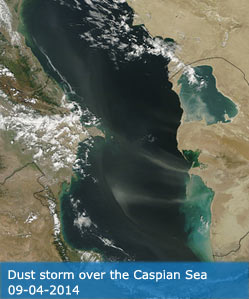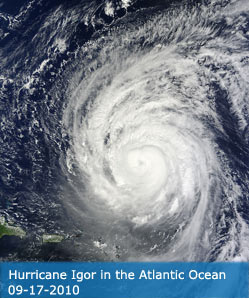Images
April 8, 2011 - Saharan dust off Portugal
Tweet
A thick plume of dust hangs over the Atlantic Ocean off the coast of Portugal in this image from the Moderate Resolution Imaging Spectroradiometer (MODIS) on NASA’s Terra satellite on April 6, 2011.
The dust blew in from the Sahara desert in North Africa, picked up by the strong winds associated with a low-pressure system. The low-pressure system channeled the dust west and then north, resulting in the plume off Portugal.
Airborne dust plays many roles in large-scale Earth processes. Dust is one of the most abundant aerosol particles in the atmosphere, and a natural seed for cloud formation. Dust particles and the clouds they generate can reflect energy from the Sun back into space, effectively shading Earth’s surface and cooling its temperature.
Dust also carries minerals, particularly iron, that help fertilize the Earth’s oceans. In iron-poor waters, dust provides essential nutrients for phytoplankton, tiny plants and plant-like organisms growing in the sunlit surface waters. In fact, a phytoplankton bloom colors the Atlantic beneath the dust in this image, although there is not necessarily a connection between the dust storm and this particular bloom.
Image Facts
Satellite:
Terra
Date Acquired: 4/6/2011
Resolutions:
1km ( B), 500m ( B), 250m ( B)
Bands Used: 1,4,3
Image Credit:
Jeff Schmaltz, MODIS Land Rapid Response Team, NASA GSFC
Tweet
A thick plume of dust hangs over the Atlantic Ocean off the coast of Portugal in this image from the Moderate Resolution Imaging Spectroradiometer (MODIS) on NASA’s Terra satellite on April 6, 2011.
The dust blew in from the Sahara desert in North Africa, picked up by the strong winds associated with a low-pressure system. The low-pressure system channeled the dust west and then north, resulting in the plume off Portugal.
Airborne dust plays many roles in large-scale Earth processes. Dust is one of the most abundant aerosol particles in the atmosphere, and a natural seed for cloud formation. Dust particles and the clouds they generate can reflect energy from the Sun back into space, effectively shading Earth’s surface and cooling its temperature.
Dust also carries minerals, particularly iron, that help fertilize the Earth’s oceans. In iron-poor waters, dust provides essential nutrients for phytoplankton, tiny plants and plant-like organisms growing in the sunlit surface waters. In fact, a phytoplankton bloom colors the Atlantic beneath the dust in this image, although there is not necessarily a connection between the dust storm and this particular bloom.
Image Facts
Satellite:
Terra
Date Acquired: 4/6/2011
Resolutions:
1km ( B), 500m ( B), 250m ( B)
Bands Used: 1,4,3
Image Credit:
Jeff Schmaltz, MODIS Land Rapid Response Team, NASA GSFC




